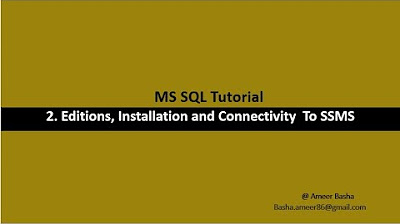#30 Introduction to Express JS | Working with Express JS | A Complete NODE JS Course
Summary
TLDRIn this introduction to Express.js, viewers learn about its role as a minimal and flexible web application framework for Node.js. The video emphasizes how Express simplifies the development process by reducing the amount of code required to build applications. It guides users through the installation of Express, creating a basic server, and handling routes for GET and POST requests. The session highlights the ease of sending responses, whether text, HTML, or JSON, showcasing the framework's efficiency in building robust web applications. Ultimately, this lesson serves as a foundational step for developers looking to leverage Express.js in their projects.
Takeaways
- 😀 Express.js is a free and open-source web application framework for Node.js that simplifies application development.
- 😀 It minimizes the amount of code developers need to write by providing built-in classes and functions.
- 😀 Express is popular in Node.js application development and is considered a standard framework.
- 😀 The framework offers robust features, including complex routing, middleware handling, and server-side rendering.
- 😀 Developers can organize their applications using the MVC (Model-View-Controller) architecture with Express.
- 😀 To start using Express, a package.json file must be generated using the command 'npm init'.
- 😀 The Express package can be installed via npm with the command 'npm install express'.
- 😀 The entry point for an Express application is usually defined in the package.json file, commonly as app.js.
- 😀 Routes in Express are defined using HTTP methods (GET, POST, etc.) combined with the URL.
- 😀 Responses can be sent in various formats, including plain text, HTML, and JSON, using appropriate methods like send() and json().
Q & A
What is Express.js?
-Express.js is a free and open-source web application framework for Node.js that simplifies the development of web and mobile applications by allowing developers to write less and simpler code.
How does Express.js improve the coding experience compared to vanilla Node.js?
-Express.js reduces the complexity of Node.js applications by providing built-in classes and functions, allowing developers to achieve complex functionalities with minimal lines of code.
What are some features provided by Express.js?
-Express.js includes features such as complex routing, easier handling of requests and responses, middleware integration, server-side rendering, and more.
How do you create a new project in Express.js?
-To create a new project in Express.js, you generate a package.json file using the command 'npm init', which sets up the project's metadata and dependencies.
What command is used to install Express.js?
-You can install Express.js using the command 'npm install express'.
What is the significance of the 'app.js' file in an Express.js project?
-'app.js' is designated as the entry point for the application, where all configurations and route definitions for Express.js will be kept.
How do you start an Express.js server?
-To start an Express.js server, you call the 'listen' method on the Express application object, passing in the port number and a callback function to execute once the server is ready.
What is the difference between handling GET and POST requests in Express.js?
-GET requests are handled using the 'get' method, while POST requests are managed using the 'post' method on the Express application object.
How do you send a JSON response in Express.js?
-To send a JSON response in Express.js, you use the 'json' method on the response object, which sets the content type to 'application/json'.
Why is Express.js considered a standard in Node.js application development?
-Express.js is widely used and recognized for its minimalism and flexibility, making it a standard choice among developers for building web applications with Node.js.
Outlines

This section is available to paid users only. Please upgrade to access this part.
Upgrade NowMindmap

This section is available to paid users only. Please upgrade to access this part.
Upgrade NowKeywords

This section is available to paid users only. Please upgrade to access this part.
Upgrade NowHighlights

This section is available to paid users only. Please upgrade to access this part.
Upgrade NowTranscripts

This section is available to paid users only. Please upgrade to access this part.
Upgrade NowBrowse More Related Video

Self Introduction | Perkenalan Diri |How to Introduce yourself in English | Cara memperkenalkan diri

A NEW JOURNEY STARTS HERE

Vektor Matematika Kelas 10 • Part 1: Definisi Vektor & Cara Menyatakan Vektor

Mock Product Manager Interview (LinkedIn PM): Improve Spotify's Social Features

Os melhores CONECTIVOS para Redação!

Part 2 A : Editions, installation and Connectivity to SSMS
5.0 / 5 (0 votes)